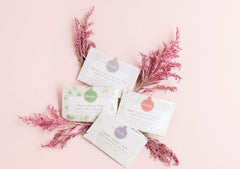The dreaded burn. If you know, you know — and this is one club that no one wants to be a part of. No one wants to deal with a UTI or a yeast infection, but 50-60% of women will experience a UTI, with 75% of women having a yeast infection. That’s sadly some large stats!

UTI vs. Yeast
With these inconvenient and sometimes a-little-embarrassing issues, we want to give you the knowledge to empower yourself and your daughters. To be prepared for either situation, here are what causes both of these infections and how to get rid of them.
Causes of a UTI vs. Yeast Infection
First, we want to hone in on preventing and identifying the causes of both of these less than convenient infections. Both infections can happen after wiping back to front or having sexual intercourse, because you’re introducing different bacteria or creating an imbalance in your body's natural pH.
The causes for UTI, a bacterial infection from e.coli in the urinary tract, can also be attributed to —
- Your anatomy (an abnormal urinary tract)
- Specific birth controls (like a diaphragm or spermicidal agents)
- Menopause
- Kidney stone history
- A suppressed immune system
- Recent urinary tract medical procedures
To help prevent UTIs, stay hydrated, wipe from front to back, pee after sex and as often as you need to, take probiotics, and get enough vitamin C. Also, be sure to wear loose-fitting clothes and change out of your bathing suit as quickly as possible to avoid infection if you get them more often.
Now, let’s turn to the yeast.
Your body is naturally equipped with a mixture of good yeast and bacteria, often referred to as pH balance, which acts as a defense against this kind of infection. An overgrowth of candida in your body and your vagina will contribute to the fungal yeast infection. This overgrowth commonly happens at specific times of life, including —
- Using an antibiotic
- Pregnancy
- A suppressed immune system
- Diabetes
- Taking oral birth control or hormone therapy
To avoid yeast infection, be sure to wear loose-fitting clothes, avoid douching, stop using scented feminine products that are made with chemicals (including bubble baths), switch from pads and tampons to other period care options, avoid very hot baths, and limit your use of antibiotics unless necessary.
You can take probiotics (like Lactobacillus acidophilus or Lactobacillus rhamnosus at 40-100 billion CFUs daily) and eat gut-healthy foods and supplements to limit the amount of candida in your body. You can also use essential oils with coconut oil to promote a healthy vaginal pH balance.
UTI vs Yeast Infection Symptoms
Burning, redness, and uncomfortable itching — without knowing the cause — can be difficult for people to talk about, especially daughters to moms or even women to their doctors. But to arm yourself with some basic answers, here are the classic symptoms for each of these infections.
General UTI symptoms include —
- The persistent urge to urinate and passing small amounts of urine
- Burning with urination
- Urine looks cloudy and has a strong fishy odor
- Pelvic pain, particularly around the pubic bone
- And, if blood is in the urine, red, brown, or bright pink in color
If your UTI is specific to your kidneys, bladder, or urethra, you will notice —
Kidneys: Back pain, high fever, nausea and vomiting, shaking and chills
Bladder: Lower abdominal discomfort, pelvic pressure, blood in urine, and persistent urge to urinate
Urethra: Burning with urination and some discharge
With a yeast infection, you will notice more localized symptoms. These can include:
- An itchy, red, swollen, and generally irritated vulva
- Vaginal pain and soreness
- Thick, white, odor-free vaginal discharge that resembles cottage cheese
- Watery vaginal discharge
- A burning sensation, especially during intercourse or while urinating
Note: Some of these symptoms overlap with other vaginal issues, so be sure to know that you have yeast and not something more complicated before choosing a course of treatment.
Once you’ve narrowed in on which of the infections you have, you can look at the ways to treat your symptoms with natural home remedies or see your healthcare professional for more complicated infections.
Treating a UTI vs. Yeast Infection
Phew, going through that list of symptoms and preventions can be exhausting. But it's so important to know what causes these issues and how to keep them as far from your body as possible! Here are the natural approaches you can take to eliminate your symptoms, once you know what infection you have.
For a UTI infection that has just started —
- Try cranberries. Start taking cranberry supplements or drink 100% unsweetened cranberry juice throughout the day.
- Be sure to stay hydrated. Urinating more can help move the infection out of your body. Aim to consume a gallon of water to flush out the infection.
- Pee when you need to. Don’t hold your urine in at all — so staying close to home may be the best thing while fighting a UTI.
- Take probiotics. If you aren’t using probiotics, get some great probiotics — you can research them on your own or get recommendations from your integrative doctor.
For strong UTI infections, antibiotics may be necessary. Don’t let your UTI linger too long, as the infection can spread to other parts of your body. If you’re struggling with fever and other symptoms, see your medical professional.
Yeast infection, since it is fungal, will never require antibiotics. Most basic yeast infections can be treated at home, but if you have symptoms quite often, you may need to be checked by your healthcare provider for underlying causes like HIV/AIDS, autoimmune issues like Addison’s, or some cancers. An excellent integrative doctor will understand both natural and medical needs and give you a proper course of action.
If you have had a yeast infection before, are sure it’s the same issue, are not pregnant, and have no STI concerns, you should be able to treat your yeast infection at home. Some home remedies can include —
- Vaginal Suppositories made with organic ingredients
- Anti-fungal supplements, including garlic
- Increasing your Zinc levels
- Supporting your digestive wellness with probiotics and healthy low sugar whole foods
We’ve heard from women all over the United States and the world who have used our cleansing vaginal suppositories with great success – ridding themselves of recurrent yeast infections for good!
Whether you have a UTI or yeast infection, be sure to read your body well and understand when you need to speak with your healthcare professional. We want to support your journey toward natural wellness and holistic living with the right resources to strengthen your body. But when you have a question about your symptoms or the severity of your infection, be sure to see an integrative doctor or functional medicine professional to get a comprehensive analysis and plan to deal with your symptoms in the best way!








